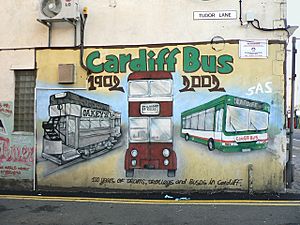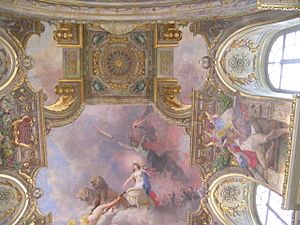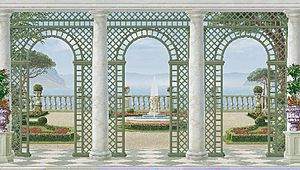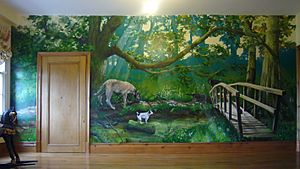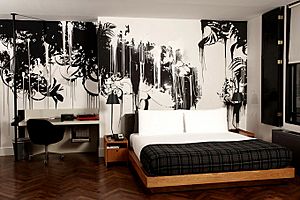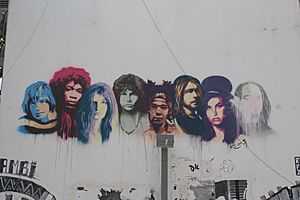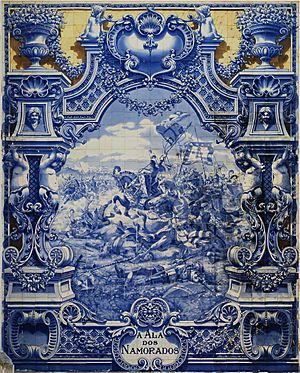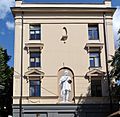Mural facts for kids
A mural is a large painting that is made directly on a wall or ceiling. Murals are often very big and can be found in many different places. Some are outside on buildings, while others are inside homes, schools, or public spaces. They are a way for artists to share stories, ideas, or beautiful designs with many people.
Contents
The History of Murals
Murals have been around for a very long time! Some of the oldest known murals were painted in caves during the Upper Paleolithic period, like those in the Chauvet Cave in France, which are about 30,000 years old.
Ancient civilizations also created amazing murals. You can find them in ancient Egyptian tombs (around 3150 BC), in the palaces of the Minoan civilization (about 1700–1600 BC), and in the Roman city of Pompeii (around 100 BC – AD 79).
During the Middle Ages, artists often painted murals on dry plaster. This method is called fresco-secco. A great example is the large collection of Kerala mural paintings from India, which date back to the 14th century. Around 1300 in Italy, artists started painting on wet plaster again. This technique, called fresco, made murals even more vibrant and long-lasting.
In more recent times, murals became very famous thanks to the Mexican muralism art movement. Artists like Diego Rivera, David Alfaro Siqueiros, and José Clemente Orozco created huge, powerful murals that told stories about Mexican history and culture.
Today, murals are painted using many different styles and techniques. One famous style is trompe-l'œil, which is a French term meaning "trick the eye." These murals are so realistic that they can make you think you're looking at a real window or a 3D object! Artists like Graham Rust and Rainer Maria Latzke helped bring this style back into fashion in the 1980s.
You can also find murals today that are made by transferring a painting or photo onto special paper or canvas. This is then pasted onto a wall, giving the look of a hand-painted mural or a realistic scene.
How Murals Are Made: Techniques

Artists have used several methods to create murals throughout history:
- Fresco: This word comes from the Italian word for "fresh." In buon fresco (meaning "good fresco"), the artist paints with pigments (colors) mixed with water directly onto a thin layer of wet, fresh lime plaster. The wet plaster absorbs the paint. As the plaster dries and reacts with the air, the colors become a permanent part of the wall. This makes the painting last for centuries with bright, fresh colors.
- Fresco-secco: This method means "dry fresco." Here, the painting is done on dry plaster. Because the plaster is dry, the artist needs to mix the pigments with a binding material like egg (called tempera), glue, or oil to make the paint stick to the wall.
- Mezzo-fresco: This technique is a mix of the two. The artist paints on plaster that is almost dry – firm enough so a thumbprint won't leave a mark. The pigment only goes a little bit into the plaster. This method became very popular by the end of the 16th century and was used by famous painters like Michelangelo.
Materials Used for Murals
In ancient Greco-Roman times, artists often used encaustic colors, which were applied cold.
Tempera painting is another old method. In tempera, the colors are mixed with a binder like egg yolk or egg white diluted in water.
In 16th-century Europe, oil painting on canvas became an easier way to create murals. The canvas could be painted in a studio and then attached to the wall.
Once a mural is finished, artists often add coats of varnish or a clear acrylic glaze. This helps protect the artwork from sunlight and damage, keeping the colors bright for longer.
Today, some young artists even use POP (Plaster of Paris) clay mixed with glue to create raised designs on a canvas board. Once the clay dries, they paint it and then add a varnish.
Besides hand-painted murals, you can also find digitally printed murals. These are created by taking a painting or photograph and printing it onto a large sheet, which is then applied to a wall. This allows for very detailed and realistic images.
Large printed advertisements on buildings, sometimes called "wallscapes," are also common. They can be painted directly onto the wall or printed on vinyl and attached, similar to a billboard.
Murals in Modern Design
Traditional Murals in Homes
Many people like to have unique murals painted in their homes to show off their personal style. You don't need a huge house for a mural; even a small wall can be transformed! The artist's fee usually depends on the time spent and the level of detail.
Murals are often painted in dining rooms, bathrooms, living rooms, and especially in children's bedrooms. A child's room can become a magical "fantasy world" like a forest or a racing track, which can spark their imagination and introduce them to art.
In the 1980s, illusionary wall paintings became popular again in homes. These murals, which often showed fake architectural features or natural scenes, could make a room feel bigger or connect people to nature, especially in crowded city areas.
Murals are also painted in public buildings like schools, hospitals, and retirement homes. They help create a pleasant and welcoming atmosphere for everyone.
Graffiti-style Murals
Recently, graffiti and street art have become a big part of modern wall painting. As graffiti became more accepted in the late 1990s, many youth brands, like Nike and Red Bull, started asking graffiti artists to decorate their offices. This trend continued, and now graffiti and street art are recognized in art galleries and museums around the world.
Ethnic Murals
Many homeowners choose to display traditional art and cultural stories from their society or historical events in their homes through murals. These ethnic murals are an important part of interior decoration. For example, Warli painting murals are very popular in India. Warli painting is an ancient Indian art form where tribal people used to draw scenes from their daily lives on the walls of their mud houses.
Tile Murals
Tile murals are made from tiles of stone, ceramic, porcelain, glass, or metal. These tiles are installed on or added to the surface of a wall, or even inlaid into floors. The tiles can be painted, glazed, or cut into pieces to form a picture.
Mosaic murals are a type of tile mural made by putting together many small pieces (from 1/4 inch to 2 inches) of colorful stone, ceramic, or glass tiles to create a larger image. Modern technology can even use computers to turn photos into mosaic patterns, making it easier to create precise murals quickly.
Azulejos are a special type of Portuguese or Spanish painted, tin-glazed ceramic tilework. They have been a key part of Portuguese culture for five centuries! You can find azulejos inside and outside churches, palaces, homes, and even train or subway stations.
Besides being beautiful art, azulejos also had a practical use, like helping to control the temperature inside homes. Many azulejos tell stories about important historical and cultural events in Portuguese history.
Today, you can even get custom-printed tile murals using digital images. These are great for kitchen backsplashes, wall displays, and floors. Digital photos and artwork can be resized and printed onto tiles using special techniques, creating unique and fade-resistant murals for both indoor and outdoor use.
Images for kids
-
A Prehistoric Egyptian mural from a tomb wall around 3,500 B.C.
-
A mural of the miners' leader Warren James at a public house in England.
-
Orr C. Fischer, The Corn Parade, 1941, an agriculture-themed mural in a post office in Iowa.
-
A mural on the Israeli separation barrier.
See also
 In Spanish: Mural para niños
In Spanish: Mural para niños


